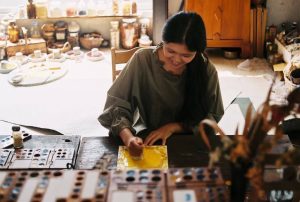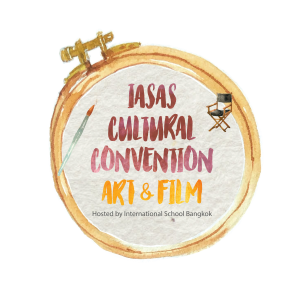 Saksombat grew up with nature. She lived in the countryside by the river. Her love for art impelled her to attend the Fine Art Program at Silapakorn University. She always felt guilty whenever she washed her brushes in the canal, causing oil from the paints to spread in the water. ‘Is there anything I can do?’ she asked herself. At the same time, her hands started to peel from using the oil paints. It was so severe that she no longer has fingerprints. She is labeled as a “disabled person” who cannot be identified by the fingerprints in her passport.
Saksombat grew up with nature. She lived in the countryside by the river. Her love for art impelled her to attend the Fine Art Program at Silapakorn University. She always felt guilty whenever she washed her brushes in the canal, causing oil from the paints to spread in the water. ‘Is there anything I can do?’ she asked herself. At the same time, her hands started to peel from using the oil paints. It was so severe that she no longer has fingerprints. She is labeled as a “disabled person” who cannot be identified by the fingerprints in her passport.
After graduating, Saksombat changed six jobs in two years. She was unhappy and felt like there was something more in the outside world. She wanted to travel but the only way for her to do so was to study aboard. Even though everyone around her opposed the decision, she was determined and applied to attend the Santiniketan University in India.
Her love for the tribal life led her to India. She loved the way people made appliances, tools and instruments that they could not afford. Creativity generated from the lack of resources intrigued her. Her allergies, coupled with her fondness for restrained creativity and an urge to help the ecosystem stimulated her to make her own drawing equipment. It was initially part of her thesis but became her life.
The process of making tools was not easy. She failed to make paper and brushes, but carried on with watercolors. “It is impossible to make colors from natural materials that can really be used,” someone told her. “What about the cave paintings made with natural colors?” she questioned. She learned a lot through trial-and-error and by traveling around India to collect valuable knowledge from several tribal artists.
She had a hard time finding the natural substance that would bind her colors with paper to prevent them from fading quickly. Fortunately, she met an 80-year-old tribal Indian artist at a forest market. He drew in a cave-painting style using four natural colors: black from the soot in a firewood stove; green from the leaves of green beans; yellow from yellow clay and red from red rocks. His binding agent, Gum Arabic. Eventually, Saksombat completed her journey in the pursuit of natural colours. She has not touched any chemical colors since.
Saksombat’s exhibitions are not just about displaying pictures. She refuses to be stuck in a studio making paintings all day. She enjoys the great outdoors, sitting and walking on grasslands. A little diary with illustrations made using natural watercolors can be found at her exhibitions. As she enjoys interacting with people and exchange stories with them, she frequently conducts workshops and activities that teach people how to make natural paint, or create postcards using her watercolors. These warm interactions are the most important to her.


